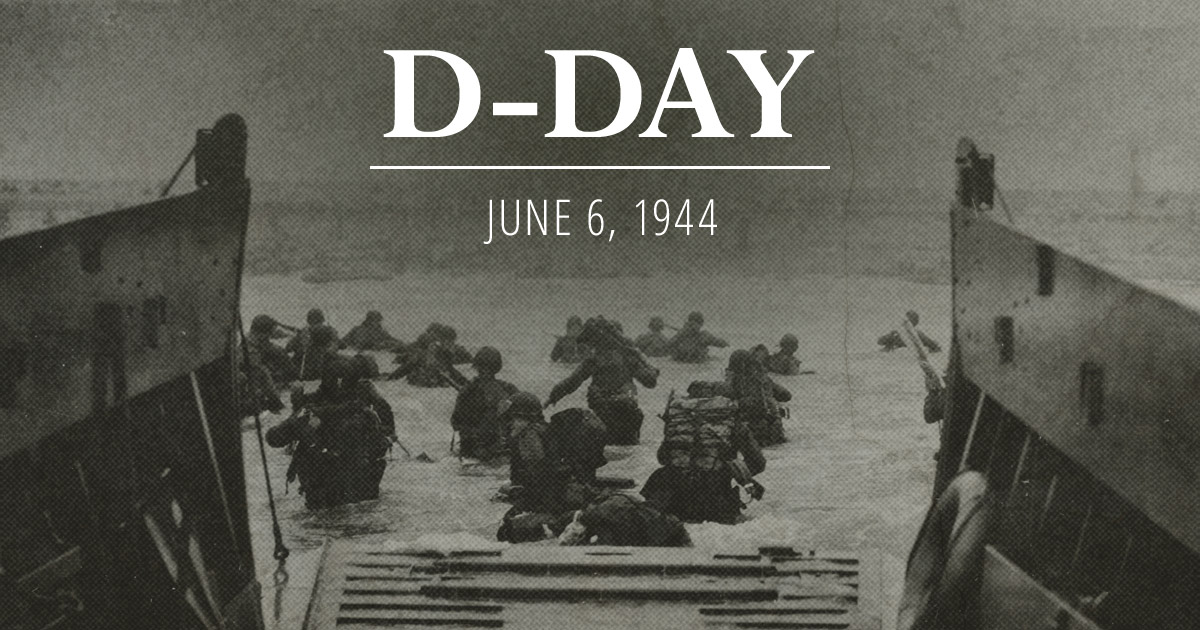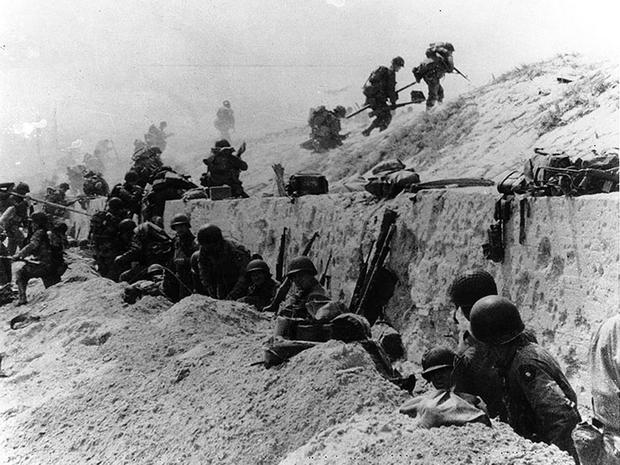D-Day: A Look Back on the 74th Anniversary
- by Super User
 Of all the key dates in history, few are as important as June 6, 1944. It was on that day, in terrible weather, that the Allied Forces launched, the long-awaited invasion of Europe, Operation Overlord, to defeat Nazi Germany and the Axis Powers. It was the largest military operation in history, fraught with peril, and with real danger that our troops would be thrust back into the English Channel in defeat. So great was the risk that General Dwight D. Eisenhower, Supreme Commander of the Allied Expeditionary Forces in Europe, wrote two press releases; one expressing appreciation for the sacrifices of American and Allied servicemen who successfully formed a beachhead on the Normandy shores of France, the second expressing the same appreciation, but taking full responsibility for the failure of the operation because of Eisenhower’s bad judgment. He concluded the second “In Case it Fails” letter with these words, “If any fault attaches to the attempt it is mine alone.” It was late in the day on June 6th before it became clear that he could release the first letter.
Of all the key dates in history, few are as important as June 6, 1944. It was on that day, in terrible weather, that the Allied Forces launched, the long-awaited invasion of Europe, Operation Overlord, to defeat Nazi Germany and the Axis Powers. It was the largest military operation in history, fraught with peril, and with real danger that our troops would be thrust back into the English Channel in defeat. So great was the risk that General Dwight D. Eisenhower, Supreme Commander of the Allied Expeditionary Forces in Europe, wrote two press releases; one expressing appreciation for the sacrifices of American and Allied servicemen who successfully formed a beachhead on the Normandy shores of France, the second expressing the same appreciation, but taking full responsibility for the failure of the operation because of Eisenhower’s bad judgment. He concluded the second “In Case it Fails” letter with these words, “If any fault attaches to the attempt it is mine alone.” It was late in the day on June 6th before it became clear that he could release the first letter.
D-Day was momentous amphibious operation, involving 5,000 Allied ships, 11,000 military aircraft, 16,000 paratroopers, 50,000 land vehicles to support the soldiers, and 143,000 ground troops. The world has never seen anything like it, either before or since.
Why was Operation Overlord so important? Consider the statistics from the two World Wars:
- 16 million deaths in World War I, (11 million military, 5 million civilian).
- 70 million deaths in World War II, (25 million military, 45 million civilian)
- Virtually the entire continent of Europe, except for Switzerland and Spain, had fallen under Nazi control by 1940. Millions of civilians, including six million Jewish people, were killed during the six-year occupation.
- America’s ally, the Soviet Union, suffered a staggering 3 million killed in World War I and 25 million killed in World War II! That was a more than 15% of their total population, and a much higher percentage of the young men on whom their future depended.
- The Nazis abducted and enslaved approximately 12 million Eastern Europeans from twenty countries (whom they considered racially inferior) to work in the German war industry with little regard to their health, safety, and lives.
In short, the Axis Powers represented a tyranny of dictators who despised individual freedom and who ruled with blood and fear. It was into this evil cauldron that first Britain and the member countries of the British Commonwealth were drawn into war in the last days of 1939 when Nazi Germany invaded Poland. England’s primary ally, France, was overwhelmed in a matter of months, leaving Britain isolated and alone to face the fury of Adolf Hitler. It was their choice to fight because, surprisingly, Hitler did not want to conquer England. In his tortured world view, the dominant nations of the world should subdue and manage the weaker ones. Thus, he envisioned a world where: 1) Germany controlled Europe and the Soviet Union; 2) England ruled the British Empire that included the world’s most populous nation, India, as well as England’s other colonial subjects; 3) the United States would stand supreme in North and South America; 4) Japan should dominate Asia, including China. In Hitler’s view, these were the racially superior countries so they should lead all others!
Fortunately, the British under Sir Winston Churchill did not accept this pernicious view of things and England declared unrestricted war on Germany. It really was only through the fortitude of Britain and her Commonwealth, and then Russia (after Hitler brazenly abrogated the German-Soviet Union Non-Aggression pact by invading the Soviet Union after getting Stalin to put his guard down), who stood between Hitler and his dark ambitions. Then, on December 7, 1941, Germany’s Asian ally, Japan, felt emboldened by Hitler’s success in Europe to attack the United States at Pearl Harbor on the Island of Oahu in Hawaii. Once in the war, America turned her industrial might to the task of defeating the Axis Powers in all the fields of battles in the world.
By the time June 6, 1944 rolled around Britain had been in the war for almost five years, America for three. The first major scene of operations in the early days of the war was in North Africa, followed by the re-conquest of Sicily in the Mediterranean, and finally the invasion of Italy, one of Hitler’s primary allies. Thus, by spring 1944, the Germans were occupied on their southern flank by the Americans and British and on their eastern flank by the mind-boggling war with Russia. Fortunately, for the Nazis, France’s early defeat had allowed the Germans to leave relatively few of their active units to stand guard against a cross-channel invasion from England. That “luxury” ended on D-Day when the third front opened in northwestern France in Normandy.
In many regards the advantage on D-Day lay with the Germans. First, they were in heavily fortified, entrenched concrete bunkers that were largely immune to air bombing, even though the Allies pounded them relentlessly in the early days of the campaign. Second, the German soldiers in Normandy were battle hardened transfers from the Russian Front, while the more than 1,000,000 Allies who would cross the English Channel during Operation Overlord were almost all inexperienced in war. The Germans had heavier and more deadly tanks than the Allies, as well as access to the natural infrastructure of France, while the Allies had to move all their equipment to the beaches of Normandy under heavy fire. And, the Nazis had laid tens of thousands of mines and vicious snares that could tear out the bottom of a landing craft all along the seacoast to destroy Allied troop and equipment ships trying to make landfall. Finally, the Nazis held the best field position – sited high above the beaches where they could fire down on Allied troops as they tried to disembark from their landing craft to crawl their way to land. Consider this harrowing and disturbing account from an LDS Soldier, Melvin D. Barney, who was part of the first assault on Normandy:
Slightly before the ramp went down, the motors opened wide. Then an armor piercing shell came right in between the angle irons of the opening. I was in the process of picking up the tripod and cradle, behind the blade of the Caterpillar (bulldozer)…I stooped down to pick that up and said to Frank, about two steps away, ‘Frank, will you hand me my rifle?’ He said, ‘Oh, geez!’ That is all I heard. He took one step over, and the next thing I knew I was down on the deck, my helmet blown off, and I had blood, flesh and brains all down my face; my face and hands were bleeding. There was nothing left of Frank from the neck up, and every time the heartbeat, there was a big gush of bright red blood…The shell continued on and hit a fellow named William D. Franko, also from Chicago. He was hit in the chest and the shell tore him completely in two…my face around my lips was bleeding from the glass from the jeep. By that time the ramp went down… i
The D-Day landings was a horror show, and 5,000 Allied troops lost their life on that single day in June, seventy-four years ago in fighting like that described by Barney.
 But the Allies also had their advantages. Primary was the meticulous planning that went into Operation Overlord – the culmination of almost two years of effort by Eisenhower and his staff. Second was Hitler’s firm belief that the invasion would be launched across the Straits of Dover on the southeastern side of England, since that was the shortest passage. Eisenhower had successfully reinforced this notion by creating a fictional “Third Army” under the command of General George S. Patton, whom the Germans believed was America’s best field general. Patton was out-of-favor for the way he treated a wounded soldier in Italy, so his penance was to make himself widely seen in eastern England walking amongst cardboard tanks and landing craft so that German spies would report that as the launching point. It took the Germans several days after D-Day to fully accept that the main assault was happening in Normandy. By the time they started moving infantry and equipment to Normandy, the beachhead was established. Perhaps the biggest advantage enjoyed by Allies was total control of the air. Germany’s mighty Luftwaffe had been destroyed in previous battles, including the Battle of Britain and the fight to control the skies over Russia and Italy, leaving them with no aircraft in France to fight off the invaders at Normandy.
But the Allies also had their advantages. Primary was the meticulous planning that went into Operation Overlord – the culmination of almost two years of effort by Eisenhower and his staff. Second was Hitler’s firm belief that the invasion would be launched across the Straits of Dover on the southeastern side of England, since that was the shortest passage. Eisenhower had successfully reinforced this notion by creating a fictional “Third Army” under the command of General George S. Patton, whom the Germans believed was America’s best field general. Patton was out-of-favor for the way he treated a wounded soldier in Italy, so his penance was to make himself widely seen in eastern England walking amongst cardboard tanks and landing craft so that German spies would report that as the launching point. It took the Germans several days after D-Day to fully accept that the main assault was happening in Normandy. By the time they started moving infantry and equipment to Normandy, the beachhead was established. Perhaps the biggest advantage enjoyed by Allies was total control of the air. Germany’s mighty Luftwaffe had been destroyed in previous battles, including the Battle of Britain and the fight to control the skies over Russia and Italy, leaving them with no aircraft in France to fight off the invaders at Normandy.
In the end, Operation Overlord was a tremendous success. By the end of August 200,000 German troops were killed to 53,000 Allied troops. That was a terrible price to pay, but it positioned the Allies so that they could close in on Germany like a vice on all sides. Many people thought the war would end by autumn 1944 when Germany saw it was in a hopeless position. But that was not to be. Hard winter fighting lay in store for the Allies as the Germans contested every inch of ground on the way to Berlin. Victory would be achieved on May 9, 1945, eleven months after D-Day. Still, D-Day was a costly, but unqualified success. It truly was a turning point in world history when the Great Democracies reasserted their influence in the world to suppress tyranny.
What about Latter-Day Saints in World War II and Operation Overlord? Almost sixty million uniformed military participated in World War II on both sides of the conflict. 100,000 members of the LDS Church served in all theaters of war, in both Allied and Axis military units. At first, that doesn’t sound like many compared to the total. But, since church membership stood at 900,000 in 1941, the 100,000 represents 11% participation in the war. The ratio for the entire United States was 9%. Of the LDS members who served, approximately 5,000 lost their lives.
It’s impossible to know how many Latter-Day Saints participated in the D-Day landings or Operation Overlord directly. But, through the “Saints at War” project at BYU, many who served came forward to tell their stories. From these histories we know that Latter-Day Saints were engaged in virtually all operational roles on June 6, 1944, including action in the Army Air Force in bombers and fighter aircraft; the Merchant Marine; the Navy; and in the Army ground forces that landed on the French beaches.
With that in mind, it’s best to leave the last word about D-Day to one of the LDS ground troops who waded ashore that rainy spring morning in June 1944. Here is what Alan Pixton, who landed at Omaha Beach, had to say after witnessing terrible carnage and suffering:
“I was wondering how we were going to get off the beach. I said I wished I could carry a foxhole with me, because that’s where I’d like to be. I tried to console the men. Some were a little frightened. I was as scared as the rest of them but couldn’t show it because you had the men there—you had to carry them along with you. Anybody that goes through that and says they are not scared is not human. People shooting at you out there is no fun. While we were going back and forth waiting to go in we were under small-arms fire. Anytime anyone popped their head up high or started moving around they’d draw some fire from way back there. I thought if I could carry my own dog tags home, I would be a happy guy…”
Fortunately, Alan Pixton did survive to bring his dog tags home.ii
Today the Normandy beaches are quiet. For seventy-four years they have been treated as sacred ground, both by the French who were liberated by Operation Overlord, and by the families and friends of those who fought there. On June 8, 1944 – two days after D-Day, the first American cemetery was established on a bluff above Omaha Beach. Today, 9,387 Americans from all branches of the uniformed military services are buried there. France granted a perpetual concession to America for this ground and it is operated today by the American Battle Monuments Commission, an independent agency of the United States Government. It is a beautiful setting, with mature trees, a large memorial, and walkways that extend right down to Omaha Beach. Almost all who visit feel it is a sacred place, where people speak quietly and walk with reverence among the hundreds of rows of white crosses that honor the lives of the young men who gave up their futures so that the world could once again be free.
Article originally published by Meridian Magazine on June 6, 2018
ABOUT THE AUTHOR
 Director Jerry Borrowman is the author of seventeen published books, including fiction and non-fiction. Most are about military history, including “Compassionate Soldier,” which won the George Washington Honor Medal from the Freedoms Foundation at Valley Forge. Jerry will act as host to a 2019 D-Day 75th Anniversary tour sponsored by Morris Murdock Travel.
Director Jerry Borrowman is the author of seventeen published books, including fiction and non-fiction. Most are about military history, including “Compassionate Soldier,” which won the George Washington Honor Medal from the Freedoms Foundation at Valley Forge. Jerry will act as host to a 2019 D-Day 75th Anniversary tour sponsored by Morris Murdock Travel.
i Dennis A. Wright. “Voices of War: The Experiences of LDS Servicemen during the D-Day Invasion” BYU Religious Studies Center. https://rsc.byu.edu/archived/regional-studies-latter-daysaint-church-history-europe/voices-war-experiences-lds Original source: Interview with Melvin Barney, “Saints at War Collection” transcript 4, pages 7-8. ii Ibid, Dennis A. Wright. Original source: Interview with Alan Pixton, 1-2, Hinckley Institute.






